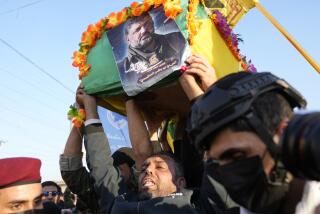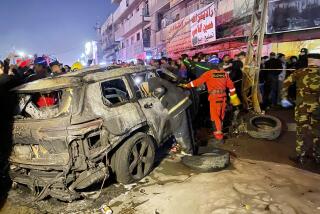In Baghdad area, Shiite festival is held without incident
The balding head of Hamid Hussein had been sliced open with a sword. Bright scarlet blood flowed down his sunburned face, trickling down and staining the white robes worn by his 5-year-old son, Hussein.
It was a momentous day for father and son. They were observing Ashura, the annual religious holiday when Shiite Muslims display penance and mourning with self-inflicted wounds to commemorate the 7th century martyrdom of Imam Hussein, a grandson of the prophet Muhammad.
There was one more reason to note the day: U.S. forces were nearly gone from all of Iraq just three weeks before the Dec. 31 deadline for their withdrawal.
“It’s better that the Americans are leaving, because we can run our own affairs now,” Hussein, 32, a stocky, white-robed resident of Baghdad’s Kadhimiya neighborhood, said this week as he wiped streaks of blood from his eyes.
But he acknowledged that his son wouldn’t be participating in the Ashura rites if not for the 2003 U.S.-led invasion. Until Saddam Hussein was toppled in the war, the country’s majority Shiites endured repression for years, their rituals banned.
“It’s was a very good thing for our religious freedom that the Americans got rid of Saddam,” Hussein said after a moment’s reflection. “But now, really, it’s time for them to go.”
U.S. forces withdrew from Iraqi cities two years ago. But this was the first Ashura in which they were no longer a major presence anywhere in Iraq. Security for commemorations, which attract car bombings and other terrorist attacks by Sunni Arab insurgents every year, has become the responsibility of U.S.-trained Iraqi security forces.
After nearly two dozen Shiite pilgrims died in attacks in Baghdad and several other cities Monday as they prepared for Ashura, police Tuesday sealed off roads within a two-mile radius of the blue-domed Shiite shrine in Kadhimiya. Participants submitted to several body searches at staggered police checkpoints while walking to the shrine, white-robed men in one line, black-robed women in another.
There were no incidents during the daylong commemorations in Kadhimiya, though roadside bombs exploded elsewhere in Iraq, wounding several Shiite pilgrims. Compared with the violence surrounding Ashura in previous years, the overall level this year has been modest.
In 2004, more than 170 people died in bomb attacks on Shiites in Baghdad and in Karbala, the southern city that houses the tomb of Imam Hussein, who died in the battle of Karbala in 680.
Police in Kadhimiya attributed the absence of violence there this week to the fully independent Iraqi security effort.
“It was a good thing the Americans did, which let people practice their religion,” said Lt. Col. Adnan Tami, who commanded a police checkpoint in Kadhimiya. “But we don’t need them for our security now. We are 100% able to take over our own security.”
After elections made possible by the 2003 invasion and Hussein’s downfall, Shiites dominate the Iraqi government. Ashura is now a public spectacle attended by millions. In Kadhimiya, thousands of Shiite families walked for miles to the shrine, pausing for free meals of hot beans and rice served by volunteers.
Taher Jabber Saadi, 48, remembered the days when he cooked biryani, a spicy rice dish, in secret in his home for family and neighbors commemorating Ashura. He posted sentries in the alleys to warn of police patrols.
“Now we are free and open, and we thank the Americans for that,” Saadi said while serving food for Ashura on Tuesday. But like many Iraqis, he holds a deeply conflicted view of the United States as part liberator, part occupying force.
“People were afraid the Americans would put even more restrictions on us” if they stayed longer, Saadi said. “They were constantly stopping us and searching us and always demanding our identity papers.”
As he spoke, young men wielding bloodied swords sang out Imam Hussein’s name. Their white robes were soaked with blood, and their sandals left bloody tracks on the pavement, where street cleaners tried in vain to wash the stains away.
The men, and some young boys, had sliced their heads or flayed themselves with chains to open wounds and draw blood.
They circled the crowded shrine, bleeding and chanting. The security police were on every street corner in their American-issued military uniforms and body armor, watching and searching for attackers, with no U.S. forces for miles.
More to Read
Start your day right
Sign up for Essential California for news, features and recommendations from the L.A. Times and beyond in your inbox six days a week.
You may occasionally receive promotional content from the Los Angeles Times.







